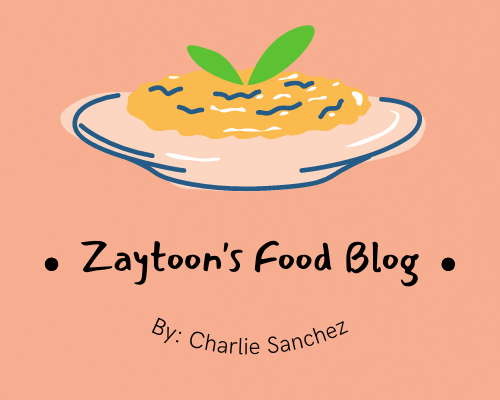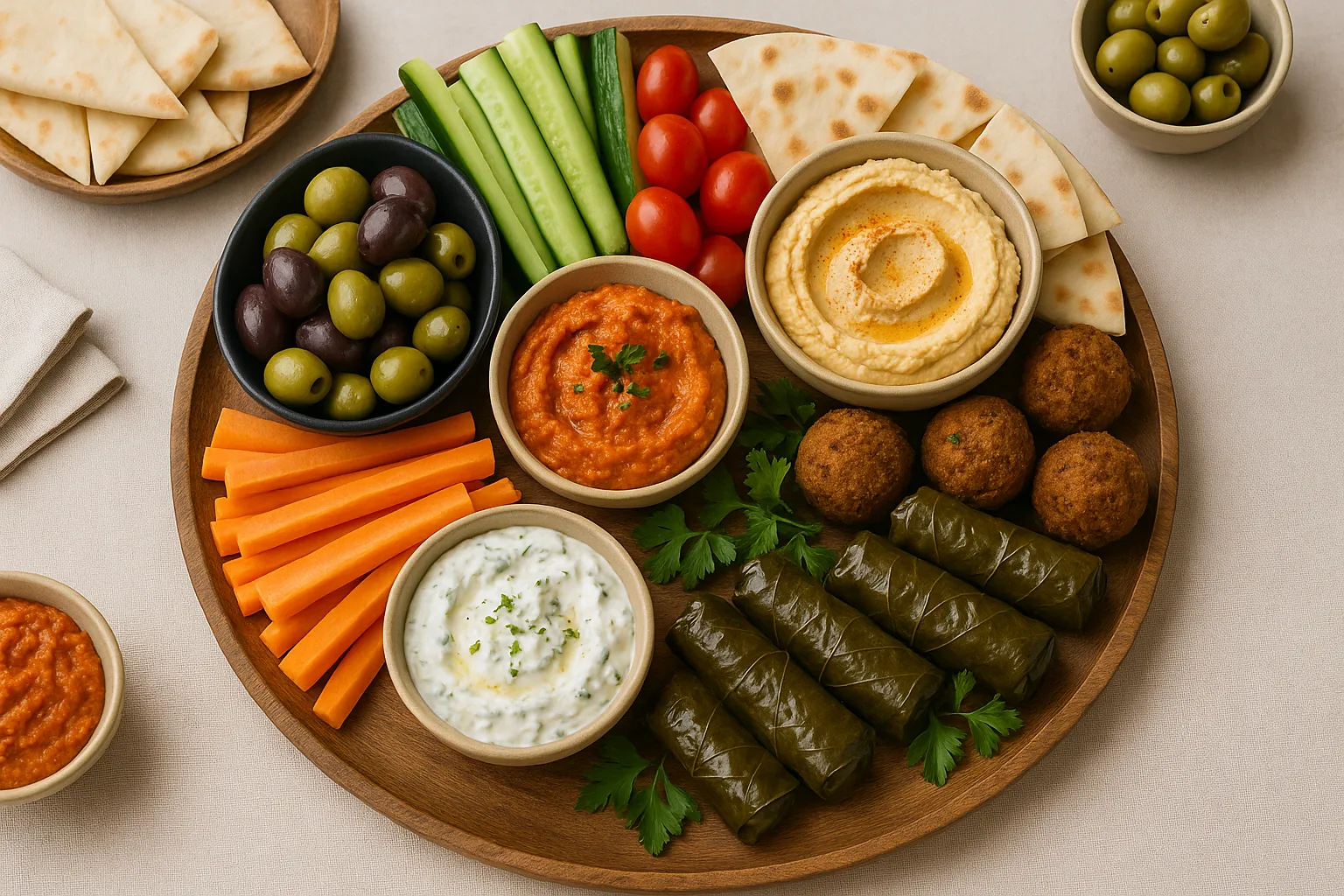Planning a mezze platter sounds simple. Then you look at all the dips, fresh herbs, vegetables, breads, and spreads, and suddenly it’s become tough. Should the food be served warm? How much do you need? And how do you make it look both generous and inviting?
This guide includes practical mezze platter ideas to help you choose the right ingredients, prep in advance, and style your board with confidence. A well-balanced mezze spread can start the meal or serve as a relaxed and social dinner on its own.
Let’s get started and put together a Middle Eastern feast your guests will remember.
What Is a Mezze Platter and Why Is It Perfect for Entertaining?
A mezze platter is a colourful, share-style spread of small dishes designed to bring people together. It’s perfect for entertaining because it’s flexible, inviting, and encourages relaxed conversation. You’ll find creamy dips, fresh vegetables, bold flavours, and satisfying textures.
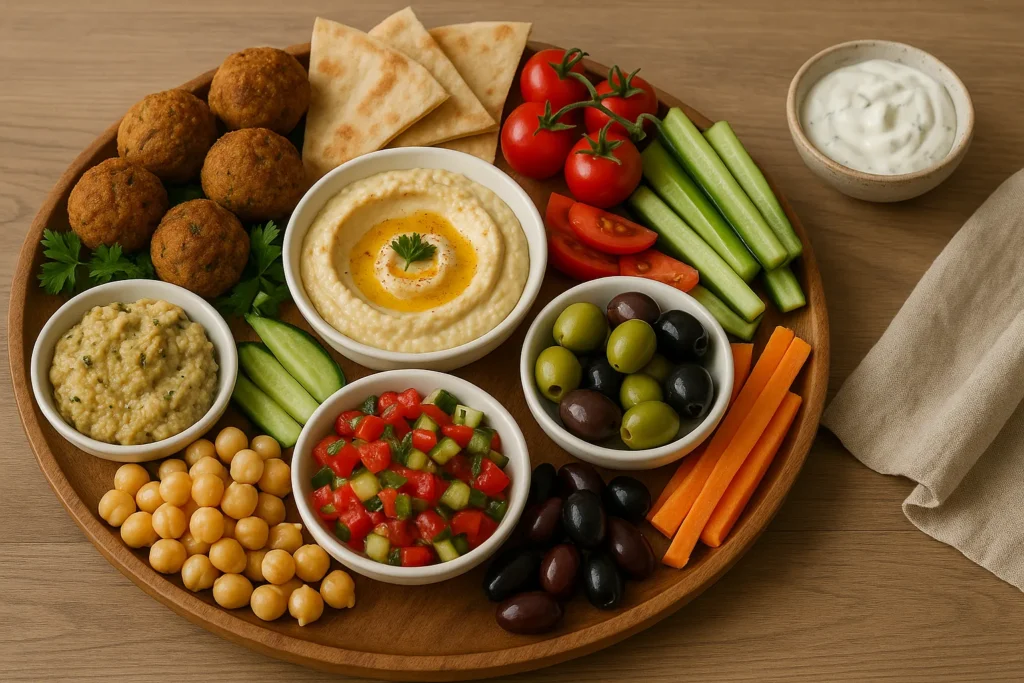
Curious how to make one that looks as good as it tastes? Let’s dive in.
What goes into a mezze platter?
If you’ve been wondering what belongs on a mezze board, here’s a simple way to think about it: aim for contrast. Include dips, raw or pickled vegetables, something salty, something warm, and always plenty of bread.
Popular additions include:
- Dips and spreads like hummus, baba ghanoush, or labneh
- Fresh vegetables such as baby carrots, cherry tomatoes, or Persian cucumbers
- Items with bite, like stuffed grape leaves, olives, or falafel
- Pita bread or flatbreads to bring it all together
This format works well because it lets people serve themselves, try what they like, and go back for more without needing separate plates or courses.
Once you start layering items onto the board, the variety brings it to life. Mixing colours, textures, and flavours turns the platter into something that looks and feels generous.
Mezze can be the entire meal
No rule says mezze must come before dinner. Add warm grilled skewers, a salad like tabbouleh or fattoush, and some sweets, and it easily becomes a full mezze dinner. It’s simple, satisfying, and always a hit with guests.
If you want to know why these ingredients work so well together, The Role of Olive Oil in Middle Eastern Cuisine shares more about the flavours that define these dishes.
Next, we’ll show you exactly what to include on your platter, from classic dips to unexpected extras that make the whole thing come alive.
Best Mezze Platter Ideas
The best part about mezze is how forgiving it is. There’s no single “right” way to build a mezze platter. The magic is in how you balance colour, texture, and flavour. When those come together, the table looks eye-catching and the spread feels generous and easy.
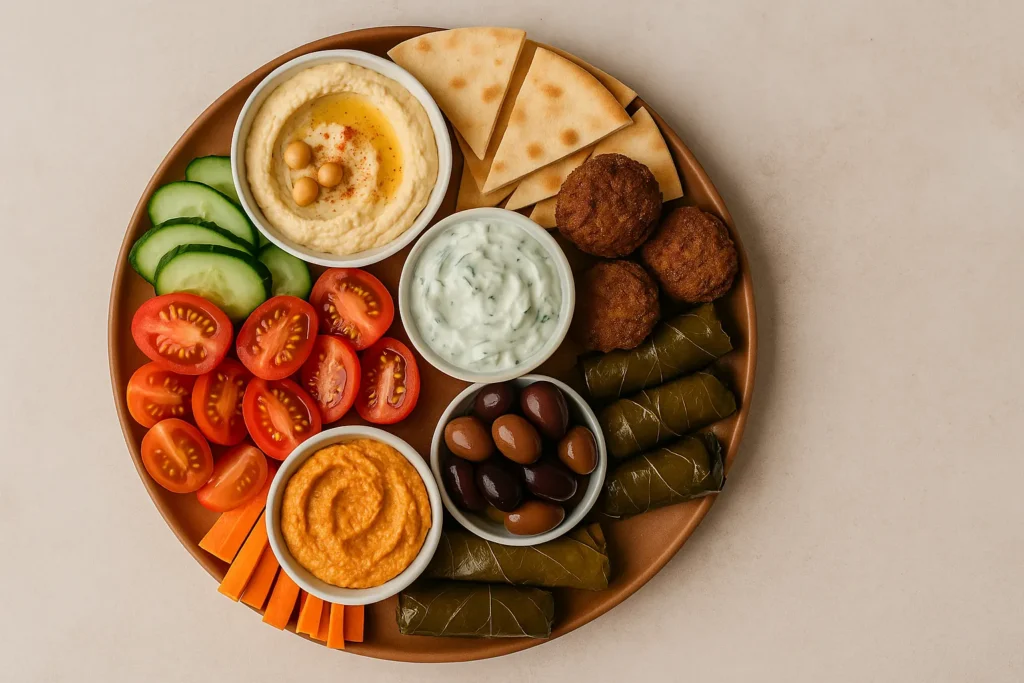
You could make everything from scratch or mix homemade with high-quality store-bought. I often do both. Prep your favourite dip, buy fresh olives and flatbread from a local deli, and build around that (I once used just labneh, pickled turnips, and warm flatbread for a weeknight dinner, and it worked beautifully).
What makes a great mezze selection?
A great mezze spread has contrast at its core. You want creamy, crunchy, salty, and fresh elements that balance each other with every scoop and bite. That’s what keeps people reaching in for more.
Here’s how to build that kind of selection:
Start with dips and spreads
- Hummus with traditional garlic and lemon, or spiced with beetroot or chilli
- Baba ghanoush, made from roasted eggplant and tahini
- Labneh finished with a swirl of olive oil and a pinch of za’atar
- Tzatziki with yoghurt, garlic, and cucumber
- Muhammara for a mixture of capsicum and walnuts
Spoon dips into small bowls and garnish with red pepper flakes, crushed pistachios, or fresh herbs. These little touches add flavour and visual depth. This is where the board starts to feel like something thoughtfully prepared, not just assembled.
Add texture with vegetables and pickles
This is where your mezze platter comes alive. Use a mix of:
- Raw options like baby carrots, cherry tomatoes, and Persian cucumbers
- Pickled vegetables such as turnips, onions, or gherkins
- Roasted or grilled vegetables like eggplant and capsicum
This combination delivers crunch, sharpness, and colour in just the right way.
Include breads and dippers
Bread connects every part of the platter. Serve:
- Soft, quartered pita bread
- Crisp pita chips or broken toasted pita
- Lavash or seeded flatbreads for variation
Group the breads near dips, or tuck them into gaps on a large platter so they feel part of the layout.
Add bold extras
Mezze becomes memorable when there’s something unexpected:
- Cubes of feta cheese or slices of grilled halloumi cheese
- A mix of olives from the olive bar
- Rolled or open stuffed grape leaves
- A few small falafels or spoonfuls of tabbouleh
Always include something salty or spiced. These sharper notes make the creamy dips taste even better.
For a closer look at how flavours work in traditional dishes, we explore that in Discovering the Heart of Middle Eastern Recipes.
Finish with a sweet contrast
Sweets create a natural stopping point and a lovely balance to savoury ingredients. Try:
- A handful of dried apricots, dates, or seasonal fruits
- Two or three pieces of baklava or almond-stuffed pastries
- A sprinkle of pomegranate seeds over dips or cheese for colour
How to Prepare a Mezze Platter: Step-by-Step
Once you’ve gathered your ingredients, it’s time to lay them out the right way. A mezze platter should look full, not crowded. Generous, not messy. Here’s how to assemble one with ease, even if it’s your first time hosting.
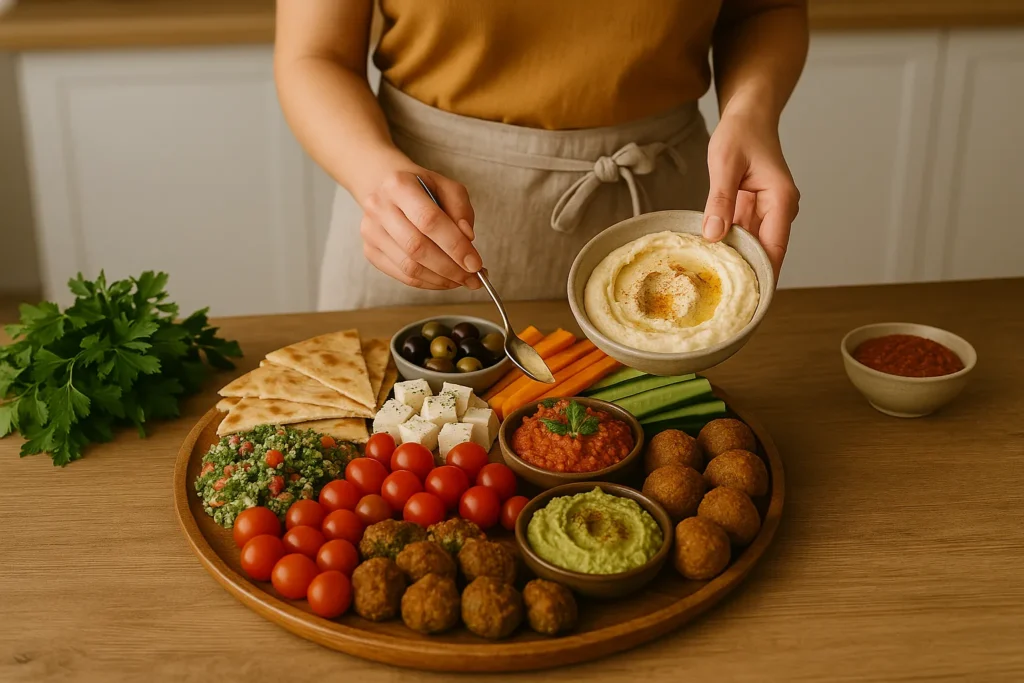
Step 1: Pick the right surface
Use a large platter, wooden board or even a baking tray. If you’re serving a bigger group, two smaller boards placed next to each other can also work.
Line the base with baking paper or a handful of fresh herbs. Place a few small bowls across the board to hold dips, olives or ingredients in oil, like marinated peppers.
Start with odd numbers, such as three or five bowls. This creates visual flow and avoids a rigid layout.
Step 2: Anchor with dips and spreads
Spoon your dips into the small bowls and space them apart to create natural zones on the board. This encourages guests to explore the whole platter rather than hovering around one corner.
Leave clear space between the bowls for vegetables, bread and extras.
(I usually go for hummus, baba ghanoush and muhammara here. They’re colourful and always disappear first.)
Step 3: Build outwards with fresh and pickled produce
Begin filling the gaps with small handfuls of fresh vegetables like baby carrots, cherry tomatoes, radishes and Persian cucumbers. Add pickled vegetables such as turnips and gherkins in between to bring a sharp edge that cuts through creamy dips.
Mix shapes and colours to keep the layout interesting and avoid repetition.
Step 4: Add bold flavours and texture
Now layer in the stronger elements: slices of grilled halloumi cheese, cubes of feta, wedges of pita bread and stacks of pita chips. Stuffed grape leaves or falafel bring substance, especially if you’re serving this as a meal.
Now, place similar items apart to draw the eye around the board. It helps create a more interactive experience for guests.
Step 5: Final touches and presentation
Tuck sprigs of herbs like mint or parsley into the corners. A scatter of pomegranate seeds can add brightness without overpowering the flavours. Include a small dish of olive oil with a spoon for optional drizzling.
Warm your pita bread just before serving and give your dips a quick stir to freshen them up. A few finishing touches can take the whole platter from good to beautiful.
What to Prep for Your Mezze Night
Planning ahead is one of the easiest ways to enjoy your mezze night as much as your guests. When you break up the prep over a day or two, the entire process feels lighter and more relaxed.
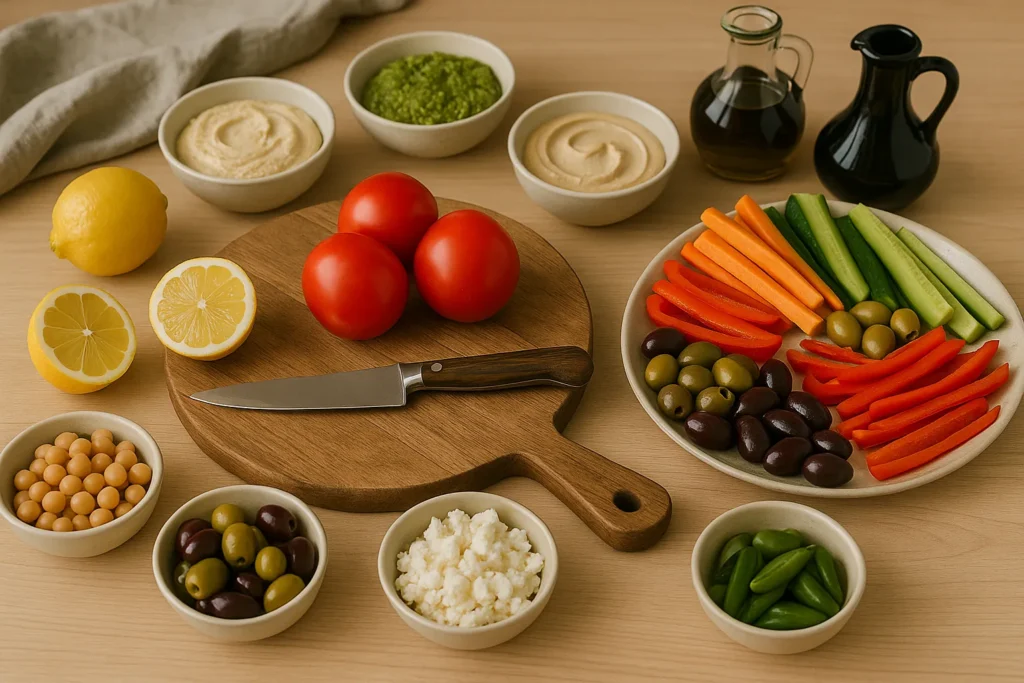
Let’s break it down.
Choose what to make and what to buy
Some mezze elements are easy to make from scratch, while others can be bought fresh and ready to serve. Focus your energy where it counts. Dips like hummus or labneh can be made a day in advance and stored in airtight containers.
Items like olives, stuffed grape leaves, and marinated vegetables are often just as good from a deli or grocer.
If you want to prep something warm, falafel and grilled vegetables can be made earlier in the day and reheated in the oven before serving. Just keep them covered and chilled until needed.
Prep vegetables in advance
Wash, peel and cut fresh vegetables like baby carrots, cherry tomatoes and cucumbers the night before. Store them in containers with a paper towel at the base to absorb moisture. This keeps everything crisp and vibrant when you’re ready to plate up.
Pickled vegetables can also be portioned ahead into small bowls, covered and kept in the fridge.
Store and reheat properly
If you’re making grilled items like halloumi, skewers or pita bread, store them separately from moist ingredients. Reheat the pita for a few minutes in the oven and give the grilled halloumi a quick flash in the pan. Don’t microwave if you want to keep the texture right.
Don’t overbuild early
If you’re tempted to assemble your board in the morning, hold off. Prepping ingredients is helpful, but build the platter just before guests arrive. That way, nothing sweats, wilts or looks tired.
Coming up next, we’ll show you how to adapt your mezze platter for different dietary needs without losing flavour, balance or visual appeal.
How to Make Your Mezze Platter Diet-Friendly
To make a mezze platter diet-friendly, offer flexible options like plant-based dips, gluten-free breads and a combination of items that suit different needs. A few thoughtful choices can make the whole spread feel welcoming for everyone at the table.
You can serve a mezze platter that suits everyone. It only takes a few thoughtful changes to make it feel inclusive, without taking away from the flavour or presentation.
Swap with ease
Adjusting ingredients is simple. Use plant-based yoghurt for labneh, gluten-free flatbread or seeded crackers instead of pita, or falafel in place of meat skewers. These substitutions combine naturally and still keep the platter interesting.
Separate to simplify
Keep gluten-free and regular bread apart. Do the same with dairy-based and plant-based dips. A quick mention to your guests when they arrive helps everyone find what they can eat.
Small touches like this make hosting easier. No one needs to ask, and you can relax knowing everyone has options.
Add a few all-rounders
Bowls of roasted chickpeas, grilled vegetables, fresh fruit slices or falafel work across most dietary needs. These additions also help the platter look fuller and colourful.
If this feels like a lot to plan, remember you’ve already done most of the work. These ideas just help you stretch it a little further, with minimal effort.
How to Make a Mezze Platter Look Inviting
To make a mezze platter look appealing, improve the colour contrast, layering, and visual flow. It should feel full, fresh and inviting without being cluttered. Guests eat with their eyes first, and when the board looks generous, the experience feels special before the first bite.
Presentation might not be the first thing you think of, but it’s often the reason guests say wow before they even take a bite.
Here’s how to make your board a feast for the eyes:
- Use layers. Stack, tuck and fold items so they look full and flowing, not flat. Lift some items in bowls, others in clusters. The mix adds depth.
- Alternate colours and textures. Avoid placing two pale items side by side. Break up creamy dips with crunchy vegetables or bright herbs.
- Tuck herbs into the corner. A little green goes a long way. Mint, parsley or dill soften the borders and add freshness to the layout.
- Vary the shapes. Combine whole cherry tomatoes, sliced cucumbers and torn pita to keep the layout visually engaging.
- Group with intention. Place items together that naturally pair. Put baba ghanoush beside grilled vegetables, and halloumi near fresh tomatoes.
- Leave breathing space. Open spots between items prevent the platter from feeling overloaded.
- Add reasonable contrast. A few pomegranate seeds, lemon wedges or a small bowl of olive oil can brighten the board instantly.
Now that your board looks the part, we’ll shift focus to the meaning behind it and understand why mezze matters and how it fits into the culture of sharing food.
Middle Eastern Mezze Culture: What Every Host Should Know
Your mezze board looks stunning. Now it’s time to go a little deeper and understand the role it plays in the culture behind it. The beauty of mezze isn’t only in how it looks or tastes, but in the way it brings people together.
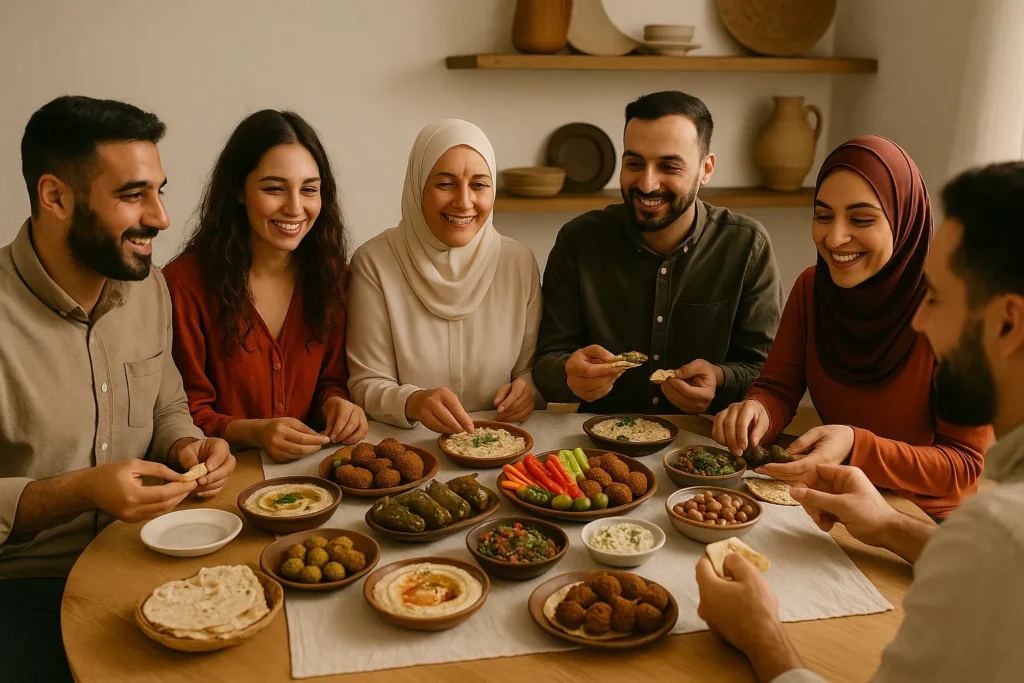
Mezze plays a central role in Middle Eastern culture because it turns food into a shared experience. Instead of everyone eating their own dish, guests gather around one table and reach for the same platter. It’s unspoken, but powerful. No one is left out, and no one needs to ask to be included.
Mezze encourages conversation, slowness and connection. In many homes across Lebanon, Syria, Jordan and Palestine, mezze is often more memorable than the main course. It’s where stories are told and friendships are strengthened.
If you’ve ever found yourself rushing through meals, mezze is the opposite. There’s no structure, no timeline. Guests can eat a little now, take a break, then go back for more. It feels relaxed, but it carries deep cultural weight.
Hosts are expected to offer variety, abundance and care. That doesn’t mean cooking for days. It means putting thought into what you serve and how you share it. If someone is new to the table, mezze is a soft entry point. It gently invites people in.
To create this same feeling in your own home, set the scene beyond the food. Light candles. Play soft music. Let your guests serve themselves and return when they’re ready. The table does the work.
If you’re curious about how flavours are layered in traditional dishes, you’ll find plenty of insight in Discovering the Heart of Middle Eastern Recipes.
Checklist for Hosting a Middle Eastern Mezze Dinner Party
This checklist makes it easy to pull everything together, whether you’re hosting two people or ten. Use it to stay organised, reduce stress, and make the experience enjoyable from start to finish.
Shopping list essentials
- 2–4 dips: hummus, baba ghanoush, labneh, tzatziki or muhammara
- Fresh vegetables: cherry tomatoes, baby carrots, radishes, cucumbers
- Pickled items: turnips, olives, artichoke hearts, gherkins
- Cheeses: feta, grilled halloumi
- Extras: falafel, stuffed grape leaves, flatbread, pita chips
- Sweets: dates, dried apricots, baklava
- Fresh herbs for garnish
- Pomegranate seeds, olive oil, lemon wedges
Serving supplies
- Large platter, wooden board or serving tray
- Small bowls for dips, olives and oily items
- Small plates and napkins for guests
- Tongs or small serving spoons for each bowl
On the day
- Prep and plate your dips
- Wash and cut all fresh produce
- Warm pita bread and grilled items
- Arrange everything on your platter close to serving time
- Add herbs, drizzles and garnish at the end
- Put on music, set the lighting and enjoy the night
If you want to know about more dishes, seasonal ideas or ways to serve mezze as a full meal, visit Zaytoons Restaurant for more inspiration.
